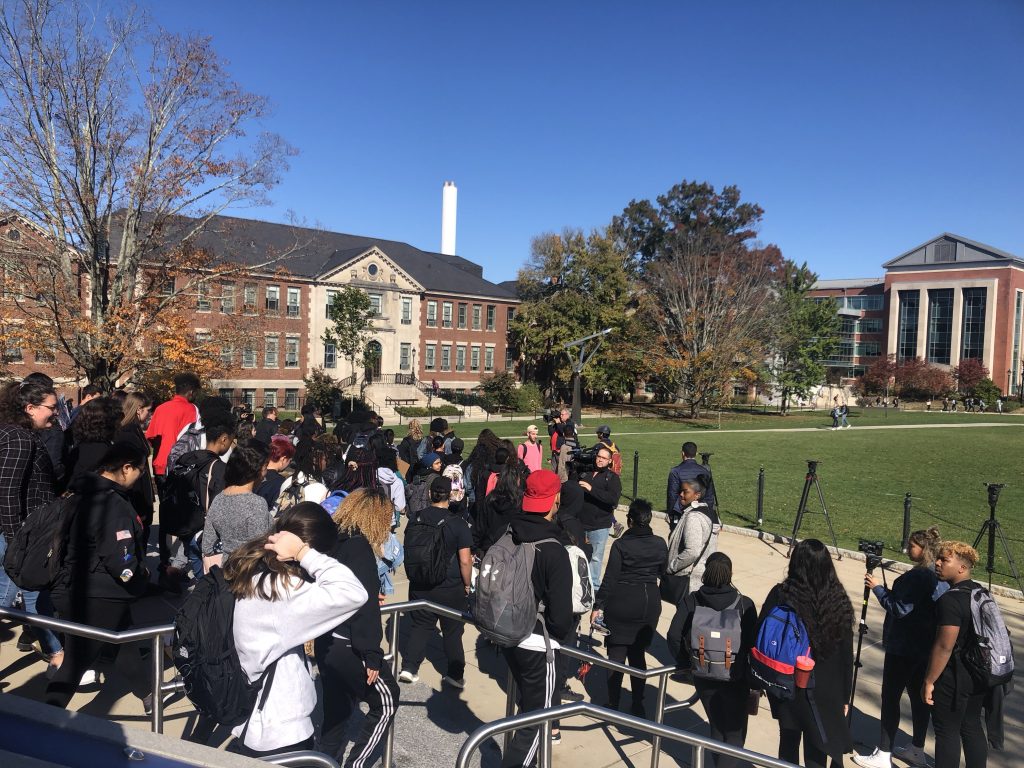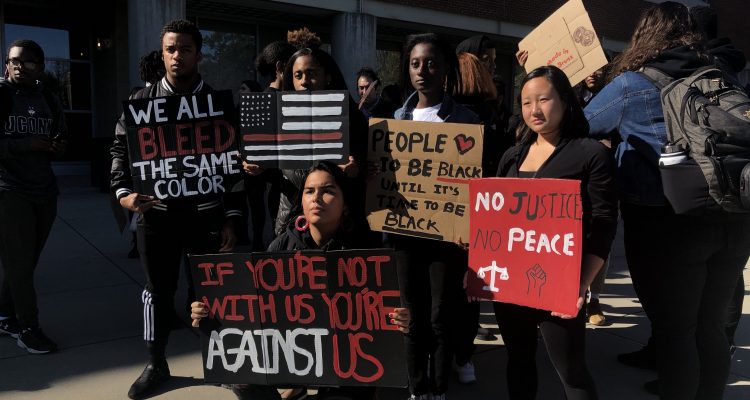By Sophia Scorziello
Tareonna Alger-Rodriguez, a UConn freshman, stood in front of the Student Union holding a hand-painted sign: “It’s not just an incident. It’s an institution,” it read. A student standing next to her held a large stack of even more signs, the one top reading “if you’re not with us, you’re against us.”
“You can’t keep us quiet,” said Alger-Rodriguez. “This is everybody’s campus.”
By this time, the five students she was accompanied by quickly turned to 15, and soon to 50.
By noon on Oct. 21, nearly 150 students gathered alongside her, ready to march across the University of Connecticut in response to recent racist actions on campus.
On the night of Friday, Oct. 11, African American students living in Charter Oak Apartments witnessed and recorded three white, male students shouting the n-word repeatedly and laughing.
Racially charged actions intensified when two UConn fraternity members used racial slurs against another student at a party.
Only hours after the march, two of the three students from the Charter Oak incident were arrested for ridicule on account of creed, religion, color, denomination, nationality or race.
Prior to this, Uconn’s NAACP Chapter demanded action from the school as written in a Letter to the Editor published by the Daily Campus.
“We demand for your full assurance that you will take appropriate measures to hold the students involved in these heinous acts of racism accountable,” they wrote.
Shelby Felix, the march organizer, made opening remarks to the crowd. She honed in on the importance of collective involvement in standing up to racism, not just from the black community.
“Racism on campus is not a black issue, it is a UConn issue,” she said.
She stressed the dangers of using tolerism in reacting to these recent incidents. “That suggests that we are unequal, that people of color are a nuisance, and that we are the thorn in the side of UConn, when in fact, each and everyone of us edifies the overall university experience,” she said. “We are all deserving of respect, and we expect as much.”
Felix then led marchers to Fairfield Way, where they stationed themselves outside of the Homer Babbidge Library.

Students, faculty, community members and press formed a large and growing circle with speakers residing at the center. For over two hours, speakers passed around a megaphone to amplify stories of personal battles with bias at UConn and their messages to those around them.
UConn President Katsouleas spoke briefly at the march, but some students were still not satisfied with his words.
“I didn’t hear anything important from him. I want action,” said UConn senior Metban Ajak from Binghamton, New York.
Ajak believes students’ demeanor toward these racial slurs is what enables them. “Kids here are explicit,” she said. “They truly don’t care.”
One student at the rally told the crowd that racial imbalance and insensitivity stemmed from her high school years, where she had to deal with white students in her classrooms saying they simply didn’t understand the purpose of the Black Lives Matter movement.
Amelia Overby, a freshman at UConn who remained on the outside of the crowd during the rally, said a common theme across speakers was unity in the issue. “It’s not just black lives that are important, it’s everyone,” she said.
But while UConn students and faculty took a holistic view of the issue, she believes it wasn’t telling of the true demographics of the campus.
Black students at UConn make up only 6 percent of the Storrs campus, according to the National Center for Education Statistics.
“I’m biracial,” Overby said. “I feel like [UConn] is predominantly white, which is fine, but you can’t keep saying we’re the most diverse.”
Walking at the tail end of the marchers was Angela Rolla, the director of UConn’s Asian American Cultural Center.
The AsACC was formed after an incident in 1987 when a group of Asian students at UConn were called racial slurs and spit on by two fellow white students. The center was then established in 1993 and has since helped to foster greater acceptance and appreciation of Asian culture at UConn.
While the damaging words yelled by these students can’t be changed, action can. “How we react to it and deal with it is going to be very important,” Rolla said.
Alongside AsACC are four other culture centers at UConn, representing the variety of cultures, races, sexualities and other things that make the student body diverse.
“When you get sick, does that not affect the overall function of your body?” was a question Felix posed to marchers. “Diversity is not the infection. Racism is.”



Please have a Susan Forbes Hansen reference Sunday the 27th show that followed her show that was very racist from 10 to 11 p.m. Susan rocks
Thanks Sophia score Zillow for her reporting of the October 11th incident on October 28th thank you Sophia